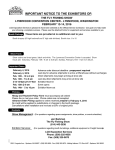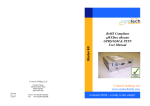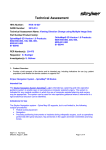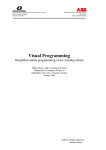Download Water System Assessment: User's Guide
Transcript
Water System Assessment User’s Guide Version 1.0 May 4, 2012 Health Protection Branch B.C. Ministry of Health Version 1.0 Preface The Water System Assessment will help an operator or owner of a water system in B.C. assess the safety and security of a water supply system. The assessment may be completed as a voluntary measure. Drinking water officers may use this tool to inspect water systems by using it co‐operatively with the operator or owner. This tool may also be used as a template for a water source and system assessment order under the Drinking Water Protection Act. Acknowledgements The Water System Assessment was developed by the Health Protection Branch of the B.C. Ministry of Health. We would like to thank the following people and organizations who have contributed to the creation of this tool: Joel Barkman, Barry Boettger, Ron Craig, Marianne Crowe, Dave Fishwick, Lynn Magee, Tom McGregor, Christine Metherall, Gordon Moseley and the Drinking Water Leadership Council ii Water System Assessment User’s Guide v 1.0 May 4, 2012 Version 1.0 Contents 1 Introduction .......................................................................................................................................... 1 1.1 What Is the Water System Assessment? ...................................................................................... 1 2 Water System Assessment .................................................................................................................... 1 2.1 Hazard Assessment ....................................................................................................................... 2 2.2 Risk Rating ..................................................................................................................................... 5 2.3 Risk Grouping ................................................................................................................................ 9 2.4 Action Planning ........................................................................................................................... 10 iii Water System Assessment User’s Guide v 1.0 May 4, 2012 1 Introduction The Water System Assessment fills a gap between the Drinking Water Source‐to‐Tap Screening Tool and the Comprehensive Drinking Water Source‐to‐Tap Assessment. The intention is to offer an alternative that will allow for developing an action plan to reduce risks to and in a water system, without the added cost and time commitment of a comprehensive assessment. This user’s guide is designed to support the assessment forms available in Microsoft Excel or hard copy. These forms will be where all the information is recorded. This guide explains how to use the forms and provides helpful tips to get you started. It also includes suggestions and examples to help you understand where problems may arise. 1.1 What Is the Water System Assessment? The Water System Assessment is a source‐to‐tap assessment designed to be completed by the water supply operator or the drinking water officer. The purpose of a source‐to‐tap assessment is to help the owner or operator of a water system to: Identify hazards and assess risks Identify ways to prioritize risks Develop a timeline for improvement The full assessment is designed to be completed in about one day: 2 Data collection: about three field hours Completing the forms: about one hour Creating an action plan: about four hours Water System Assessment The Water System Assessment is composed of this user’s guide and three forms that can be completed by hand or computer (Microsoft Excel). Both will yield the same results. However, if you are able to use the computer version you will have access to extra features such as information brought forward to the next form and automatic calculations. The Water System Assessment is designed to enable quick and efficient data collection. The tool consists of these forms: 1. Hazard Assessment: The questions in this form take you step by step through your water system. They are designed to cover the water system from the water source through to the customer’s taps. 2. Risk Rating: This form breaks the potential problems (hazards) down to try to identify how serious they are (risk). 3. Risk Grouping: This form orders the hazards into similar groupings to help you see areas that need the most work. This will add perspective to help you deal with the risks to your system. 4. Action Plan: This will be a short report to develop timelines and prioritize system improvements. Undertaking this assessment will help the operator see solutions that would not be apparent with a long list of problems that can make any improvement seem overwhelming. 1 Water System Assessment User’s Guide v 1.0 May 4, 2012 Version 1.0 2.1 Hazard Assessment The Hazard Assessment form (Form One) consists of about 140 questions about your water system. It covers everything from the water source area, through your treatment and distribution, to the tap of the end user. The idea is to answer these questions as you walk around your water system to identify hazards that could impact safe drinking water. Figure 1: Form One: Hazard Assessment 2.1.1 What Is a Hazard? A hazard is anything that has the potential to harm the water supply. This could be to safety (quality) or availability (quantity) of the water. The word “potential” indicates that a hazard may be something real, but also something that could be real under certain conditions. Example: Cows are in your watershed, and your well is shallow and susceptible to surface water runoff. The cow manure is a hazard to the water supply, even if the manure is not currently running into the well. It is enough to note that there is a possibility it will. 2.1.2 How Are the Forms Organized? Questions are asked that cover the elements of a typical water system. They are ordered so they can be answered in a walkthrough of your system. Topics are ordered as follows: 1. 2. 3. 4. 5. 6. 7. Contact information and management structure Source area Intake Water system elements (storage, pumps, treatment, distribution) Water quality and quantity Water system operation Finances 2 Water System Assessment User’s Guide v 1.0 May 4, 2012 Version 1.0 Questions are either relevant to each source or to the water system. The hazard assessment form is designed for assessing up to three water sources. If there are more than three sources in your system, you will need to complete a second hazard assessment form. Example: 1. A system gets water from a main well. 2. A second well is used only when the main well water level is low. 3. A surface water source was functioning a long time ago, but has been abandoned. The numbers 1‐3 or the word system appears to allow separation of information according to element. Space is available for detailed answers to each question under the heading “Descriptive Information.” To the right you will notice smaller spaces under the heading “Specific Hazard.” Here is where you document any hazards related to the question. There is space for up to two hazards for each source or system. Keep hazards to the space provided, as this information will be automatically populated into the next two forms (Risk Rating and Risk Grouping). 3 Water System Assessment User’s Guide v 1.0 May 4, 2012 Version 1.0 On the left column there is colour coding for certain questions. This is to help you identify a series of questions that are specific to a certain system type, allowing you to skip if the questions are not applicable to your system configuration. The white boxes are general questions and should be answered by everyone. The blue boxes are specific to surface water sources. The brick red boxes are specific to well sources. The green boxes are specific to systems with filtration or disinfection treatment. Note: If there is missing information in the existing questions, these points should be documented in the space provided for questions that do not apply to your system. 2.1.3 Guidance to Identifying Hazards Learning to identify system hazards can be difficult. Section 3, Guidance to Answering Questions in the Hazard Assessment, contains some tips and questions to help you think of what hazards may be attributable to certain types of questions. Please keep this guide with you during the assessment, as these tips will be most useful if considered when in the field. 4 Water System Assessment User’s Guide v 1.0 May 4, 2012 Version 1.0 2.2 Risk Rating Once you have completed the hazard assessment, you can proceed to rating the risk. In Risk Rating (Form Two), each of the hazards identified on Form One are examined to determine severity. Figure 2: Form Two, Risk Rating 2.2.1 How Do I Determine Risk? To help with this form we will need to explore the concept of “risk.” Risk is the combination of the likelihood that a hazard will occur and cause harm, and the extent and degree (consequence) of that harm. To understand the risk, consider the hazard in two ways: 1. How likely it is to happen (the potential)? 2. What is the consequence if it happens? Example: Walking on a rotten suspension bridge is taking a risk (use at your own risk!). Falling off the bridge is the hazard (falling hazard!). How likely is it that you will step on a rotten board and fall through? If you fall through, will you fall to your death or just sprain your ankle? Hazard = Falling Risk = (Likelihood of falling) x (How bad is falling going to hurt) 5 Water System Assessment User’s Guide v 1.0 May 4, 2012 Version 1.0 2.2.2 Likelihood, Consequence and Risk Tables The following three tables help assign a number value to a concept that is qualitative. Likelihood helps convert an abstract idea such as “sometime in the next 10 years” to the number “2”: Table 1: Likelihood Level Descriptor Description Probability of Occurrence in Next 10 Years 1 Rare May only occur in exceptional circumstances. <10% 2 Unlikely Could occur at some time. 10‐30% 3 Possible Will probably occur at some time. 31‐70% 4 Likely Will probably occur in most circumstances. 71‐90% 5 Almost Certain Is expected to occur in most circumstances. >90% Consequence helps convert impacts to the end users such as “severe illness to a large population” to the number “5”: Table 2: Consequence Level Descriptor Description 1 Insignificant Insignificant impact, no illness, little disruption to normal operation, little or no increase in normal operating costs. 2 Minor Minor impact for small population, mild illness moderately likely, some manageable operation disruption, small increase in operating costs. 3 Moderate Minor impact for large population, mild to moderate illness probable, significant modification to normal operation but manageable, increased operating costs, increased monitoring. 4 Major Major impact for small population, severe illness probable, systems significantly compromised and abnormal operation if at all, high‐level monitoring required. 5 Catastrophic Major impact for large population, severe illness probable, complete system failure 6 Water System Assessment User’s Guide v 1.0 May 4, 2012 Version 1.0 The Risk Rating table takes the numbers assigned to likelihood and consequence as inputs, and then assigns a number to the risk. A likelihood of “2” and a consequence of “5” give a risk of “4 (Very High).” Table 3: Risk Rating Likelihood Consequences 1 (Insignificant) 2 (Minor) 3 (Moderate) 4 (Major) 5 (Catastrophic) 1 (Rare) 1 (Low ) 1 (Low) 2 (Moderate) 3 (High) 3 (High) 2 (Unlikely) 1 (Low) 1 (Low) 2 (Moderate) 3 (High) 4 (Very High) 3 (Possible) 1 (Low) 2 (Moderate) 3 (High) 4 (Very High) 4 (Very High) 4 (Likely) 2 (Moderate) 3 (High) 3 (High) 4 (Very High) 4 (Very High) 5 (Almost certain) 2 (Moderate) 3 (High) 4 (Very High) 4 (Very High) 4 (Very High) The following examples demonstrate how to determine the likelihood, consequence and risk: Example 1: There are cows in a pasture close to your water intake. The raw water is not treated. Hazard: Feces getting into the water supply. Likelihood (the likelihood of the feces contacting your water source): Are the feces upslope or downslope of the intake? Is the water source surface or a well? If the water source is a well, is the well drawing from a confined aquifer or susceptible to contamination by surface water? Likelihood scenarios: Feces located upslope of a surface or susceptible well water intake are Likely to enter the source water. Feces located downslope of a surface water intake are Unlikely to enter the water source. Consequence (how bad it will be when the feces contact the water): Feces may carry pathogens such as E. coli or Cryptosporidium. Pathogens in the delivered water may get someone sick and will trigger an immediate boil water notice. Due to the significance of getting someone sick, the consequence is Moderate. Risk (likelihood of the feces contacting the water source X how bad it will be if it does): A. The likelihood is Likely and the consequence is Moderate, so the risk is High. B. The likelihood is Unlikely and the consequence is Moderate,” so the risk is Moderate. The risk would be reduced by disinfecting the water. 7 Water System Assessment User’s Guide v 1.0 May 4, 2012 Version 1.0 Example 2: Your well was developed several years ago. It does have a well cap, but no vent. Because there is no vent, muddy water and animal manure is sucked into the electrical conduit every time the pump draws down. Hazard = Mud and manure shorting out the electrical conduit. Likelihood = Will this happen the next ten years? Almost Certain Consequence = When this happens the whole system fails due to the electrical failure. Major Risk = (Almost Certain x Major) = Very High 2.2.3 How Do I Complete the Risk Rating Form? All hazards identified in the hazard assessment will be automatically brought forward to the “Hazard” boxes of the Risk Rating Excel spreadsheet. If you are completing the forms manually, you will need to write each hazard in the box according to the question number. The next two columns require you to enter a number for Likelihood and a number for Consequence. These numbers need to be determined specifically for your situation using the Likelihood and Consequence tables (provided here and on the form). Once you have entered the number value, based on your opinion about the hazard, the Excel spreadsheet will automatically populate the next column with the Risk Rating. If you are filling in the forms by hand, you will need to determine this number manually. The risk rating is determined by using the Risk Rating table, which generates a number from 1 to 4 (Low to Very High). The higher the number is, the higher the risk posed by the hazard you identified. To manually determine the risk rating, follow the table over from your Likelihood number and down from your Consequence number. 8 Water System Assessment User’s Guide v 1.0 May 4, 2012 Version 1.0 The risk rating for each individual hazard will give you a general idea about whether you need to do work to maintain a safe and secure water system. Hazards could be sorted now based on highest risk; however this gives a narrow view of the issues. The next form, Risk Grouping, will help you understand the bigger picture. 2.3 Risk Grouping Form Three, Risk Grouping, helps group risks into similar categories to gain perspective on the clusters of issues and help identify the system elements that require the most attention. In the Excel spreadsheet, the hazards will be brought forward to the new worksheet in smaller groupings. The form will generate a total score for all the risk numbers in the group. If you are filling in the forms by hand, you will need to group the hazards from the Risk Rating form manually, based on question number – or look for natural groupings of higher risk numbers on the risk rating form. Figure 3: Form Three, Risk Grouping Example: A system has two elements that have risks: The water source is not secure, based on seasonal draw down of the aquifer. The distribution system is deteriorating (rusting couplings, undersized lines and/or missing backflow preventers). In this case, let’s assume that fixing all the distribution risks will cost the same as sourcing, drilling and connecting a new well. Let’s also assume you only have enough contingency funding to fix one element. You may want to consider the economies of scale and reduce the total number of risks on the system by fixing the distribution system. But is that the right choice if there is another drought this year and the water supply is disrupted during the summer months? With all of this information, you may choose to spend your money on the new well and continue to patch the rusted couplings. To regenerate the contingency fund, you could levy the users with a monthly surcharge to generate the capital needed to fix the distribution system next year. This example demonstrates how grouping risks into system elements can help you see solutions that might not be apparent with a long list of problems – which can make any improvement seem overwhelming. 9 Water System Assessment User’s Guide v 1.0 May 4, 2012 Version 1.0 2.4 Action Planning Creating a successful action plan can be a challenge. Now that you have looked at your system and determined the hazards and grouped the risks, you need to establish priorities to create a realistic action plan. Hazards with the highest risk are not automatically the highest priority, since restrictions such as finances, time, technology and source area control need to be considered. Establishing priorities to improve your system is not something that can be generated by the forms. The risk rating and risk grouping will help you visualize the severity of problems your system faces. You will then need to decide which risks: 1. Must be addressed immediately. 2. Should be scheduled as funds and time allow. 3. You are willing to accept (monitor, but not attempt to fix). Take some time to consider all of your options. Once you understand your situation, you may wish to consult your drinking water officer to help develop an action plan that will most effectively address the risks, where needed, and help you deliver water as safely and securely as possible. The action plan should be formally documented in a simple report format. The report does not need to be complicated, but should focus on the following: 1. Introduction: basic summary of the water system (size, type, source, customer base). 2. Summary of priority review: a table with the following headings would make this clear: Priority Hazard Risk Description of Work Estimated Timeline Combine # Rating Cost to with # Complete Leak in 4 Dig mainline where $2000 One 7 1 mainline leak is suspected and month replace. Rusted 2 Dig mainline and $2000 One year 1 7 coupling replace all coupling.s 3. Financial plan: Summary of cash flow and a plan for raising capital for larger‐cost items. 10 Water System Assessment User’s Guide v 1.0 May 4, 2012




















